
The dwarf wedgemussel is an endangered species of freshwater mussel, an aquatic bivalve mollusk in the family Unionidae, the river mussels.
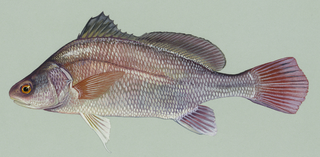
The freshwater drum, Aplodinotus grunniens, is a fish endemic to North and Central America. It is the only species in the genus Aplodinotus, and is a member of the family Sciaenidae. It is the only North American member of the group that inhabits freshwater for its entire life. Its generic name, Aplodinotus, comes from Greek meaning "single back", and the specific epithet, grunniens, comes from a Latin word meaning "grunting". It is given to it because of the grunting noise that mature males make. This noise comes from a special set of muscles within the body cavity that vibrate against the swim bladder. The purpose of the grunting is unknown, but due to it being present in only mature males and during the spawning season, it is assumed to be linked to spawning.

Unionida is a monophyletic order of freshwater mussels, aquatic bivalve molluscs. The order includes most of the larger freshwater mussels, including the freshwater pearl mussels. The most common families are the Unionidae and the Margaritiferidae. All have in common a larval stage that is temporarily parasitic on fish, nacreous shells, high in organic matter, that may crack upon drying out, and siphons too short to permit the animal to live deeply buried in sediment.

The brook floater or swollen wedgemussel, Alasmidonta varicosa, is a species of freshwater mussel, an aquatic bivalve mollusk in the family Unionidae, the river mussels. It measures 25.1 mm to 80.2 mm in length although other research also suggests it rarely exceeds three inches (75 mm).

Ellipsaria lineolata is a species of freshwater mussel, an aquatic bivalve mollusk in the family Unionidae, the river mussels. This is the sole species in the monotypic genus Ellipsaria . This species is native to the drainage systems of the Mississippi River, the Mobile River, the Tennessee River, and the Cumberland River in the United States. It exists in the midwestern United States, and has also been observed in the east coast and as far south as the Gulf of Mexico. The common name of Ellipsaria lineolata is the Butterfly Mussel.

The oyster mussel is a rare species of freshwater mussel in the family Unionidae. This aquatic bivalve mollusk is native to the Cumberland and Tennessee River systems of Kentucky, Tennessee, Alabama, and Virginia in the United States. It has been extirpated from the states of Georgia and North Carolina. It is a federally listed endangered species of the United States.

Epioblasma flexuosa, the arcuate pearly mussel or leafshell, was a species of freshwater mussel, an aquatic bivalve mollusk in the family Unionidae, the river mussels. This species was endemic to the United States, where it was found in the major drainages of the Ohio River, including the Cumberland, Tennessee, and Wabash Rivers. Its natural habitat was flowing water.

Epioblasma stewardsonii, the Cumberland leafshell or Steward's pearly mussel, is an extinct species of freshwater mussel in the family Unionidae.

The Carolina heelsplitter is a species of freshwater mussel, an aquatic bivalve mollusk in the family Unionidae.
The green floater is a species of freshwater mussel, an aquatic bivalve mollusk in the family Unionidae, the river mussels.

The Louisiana pearlshell, Margaritifera hembeli, is a rare species of bivalve mollusk in the family Margaritiferidae. This freshwater mussel is native to Louisiana in the United States, and was previously present also in Arkansas. It grows to a length of about 10 cm (4 in) and lives on the sand or gravel stream-bed in riffles and fast flowing stretches of small streams. Its life cycle involves a stage where it lives parasitically inside a fish. This mollusk is sensitive to increased sedimentation and cannot tolerate impoundments. Because of its limited range and its population decline, the International Union for Conservation of Nature has rated this mollusk as being "critically endangered".

Pegias is a monotypic genus of freshwater mussels in the family Unionidae. This genus contains the single species Pegias fabula, known commonly as the littlewing pearlymussel.
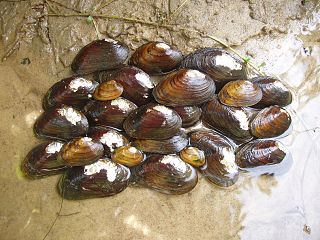
The James River spinymussel, also known as the Virginia spinymussel, is a species of freshwater mussel in the family Unionidae, the river mussels. This species is native to North Carolina, Virginia, and West Virginia in the United States. It is a federally listed endangered species of the United States. It was formerly placed in Pleurobema but in 2017, Perkins, Johnson & Gangloff placed the species into a new genus Parvaspina on account of genetic data and its lateral spines.

Pleurobema oviforme, the Tennessee clubshell, is a species of freshwater mussel in the family Unionidae, the river mussels. It is native to the eastern United States, where it occurs in Alabama, Kentucky, North Carolina, Tennessee, and Virginia. It also previously occurred in Mississippi.

Theliderma intermedia, the Cumberland monkeyface pearly mussel or Cumberland monkeyface, is a species of freshwater mussel in the family Unionidae, the river mussels. This aquatic bivalve mollusk is native to Tennessee and Virginia in the United States. Historically widespread in the upper Tennessee River system, it populations have been reduced by habitat destruction and pollution. It now only occurs in two tributaries: the Duck and Powell Rivers. It is a federally listed endangered species.
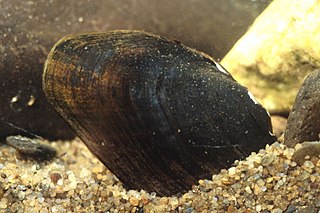
Villosa trabalis, the Cumberland bean pearly mussel, Cumberland bean, or purple bean, is a species of freshwater mussel, an aquatic bivalve mollusk in the family Unionidae.

The warpaint shiner is a species of freshwater fish found in North America. It is common in the upper Tennessee River basin as well as in the Savannah River, the Santee River, and the New River in North Carolina. Adults have a mean length of 9 centimetres (3.5 in) and can reach a maximum length of 14 centimetres (5.5 in). The maximum age reported for this species is 4 years.
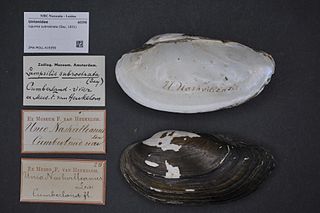
Sagittunio subrostratus, commonly referred to as the pondmussel or black pondmussel, is a species of freshwater mussel, an aquatic bivalve in the family Unionidae, the river mussels.

Utterbackia is a genus of freshwater mussels, aquatic bivalve mollusks in the family Unionidae.
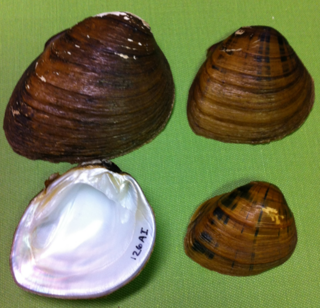
Pleuronaia dolabelloides, the slab-sided naiad, slab-sided pearly mussel, or slabside pearlymussel, is a species of freshwater mussel, an aquatic bivalve mollusk in the family Unionidae, the river mussels. This species was formerly classified under the genus Lexingtonia.





















